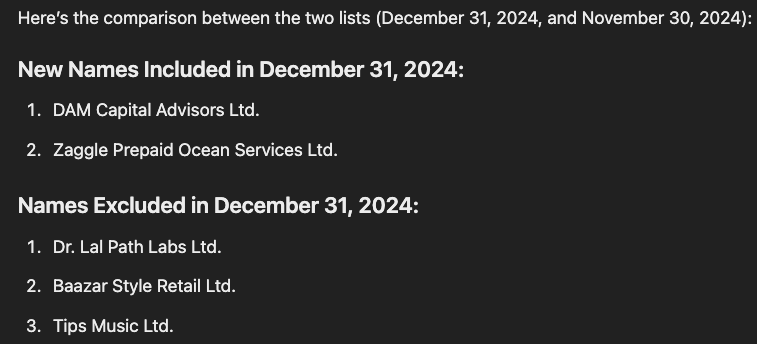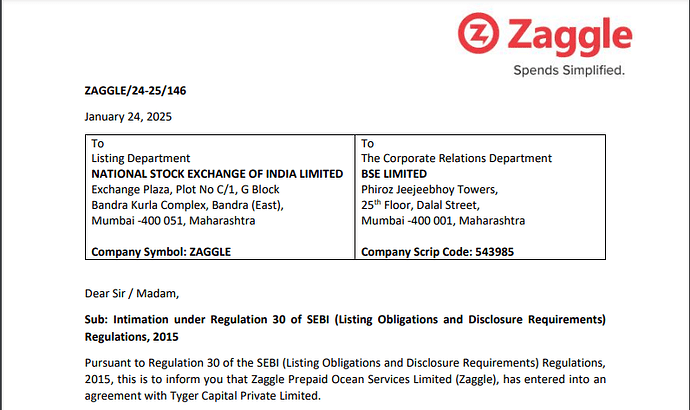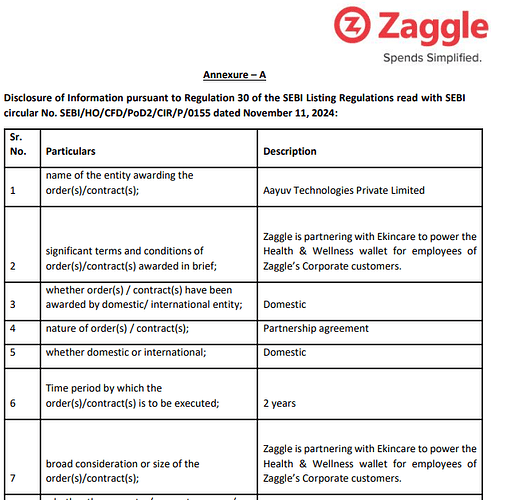Why did it hit lower circuit out of the blue?
Maybe someone already had the news so wanted to buy cheap :).
which news are you referring to?
fuel card partnership
Although inorganic expansions are looked at slightly negatively in general, however in case of Zaggle, it should be positive as it will increase cross sell opportunities to existing customers…company is trying to expand into full stack solution provider around expense management, payments (domestic & international), prepaid cards etc…this should help them increase returns per customer…
how did you get this data?
Just uploaded both factsheets for Nov and Dec on chatGpt and asked her to compare.
Great news! Finally fund managers are also noticing spend management industry.
afa7031e-79a3-43c7-b870-a3765dc717e5.pdf (5.8 MB)
Zaggle enters agreement with HT Media for employee expense management.
Equirus_Securities_Zaggle_Initiating_Coverage_Note.pdf (1.1 MB)
this is some old brokerage report but what I found is they have explained zaggle business beautifully, so guys do check if still someone doesn’t understand the zaggle business
So it’s just a credit card company atp?
Yes, thats actually it is
I had to look up the abbreviation ATP ![]() but yes that’s exactly what one of their two businesses is.
but yes that’s exactly what one of their two businesses is.
The other business is the rewards platform business which is another business model that has been around for awhile.
Sodexo is probably the oldest company in this space in India and their business model is exactly the same.
Hey folks…
I have some doubts about Zaggle. If possible kindly share your thoughts
The Zaggle application interface and customer support seem quite average, with many 1-star ratings on the Play Store. Given that, why are customers still sticking with Zaggle? Over the last 4 years, the average customer churn rate has been below 2% (currently around 1.5%).
In the USA, Ramp and Brex are big players in the spend management space. They also earn a significant portion of their revenue from interchange income (similar to the program fees for Zaggle). Ramp and Brex’s valuations are skyrocketing every year, with their price-to-sales ratio now approximately 8 to 10 times. Of course, their tech stack and user integration would likely be more advanced compared to Zaggle. However, they still earn most of their income from card fees, similar to Zaggle. So, isn’t it reasonable to apply similar multiples to Zaggle?
Replying to @hunter 's post
On churn figures of Zaggle
In my original post, I have mentioned that Zaggle should not be considered a SaaS company as it charges a very, very low subscription fee of ~Rs100/employee/year to its customers. Reproducing table below
For comparison, SaaS apps such as SAP or Salesforce charge in the range of Rs 5000-1L/employee/year depending on the features. (comparison here is between a real SaaS app charges and what one which isn’t charges, not the business)
Essentially Zaggle is something that customers provide to their employee as a “perk” which that costs them only Rs 100/employee/year & in many corporates, there are probably multiple such platforms provided as “perks” to employees e.g. Sodexo etc
So a churn figure is misleading because it costs the corporate/SME basically nothing - why would you churn from something that is basically free?
In fact, you bring up a good point that Zaggle’s app should be used for tracking its performance as Zaggle’s revenues come almost entirely from usage of prepaid cards and redemption of rewards on the app.
In my view, Zaggle should actually report DAUs/MAUs and other metrics of the app as that’s crucial.
Comparison with Ramp/Brex
So I haven’t looked at Ramp/Brex and had a quick look after your post. So Zaggle’s P/S ratio is currently 6.16 so its not really that far off from 8-10x P/S.
Also, neither appear to be publicly traded so I’m assuming you must be referring to its private valuations after venture funding rounds. IMHO, you can’t compare the two as very different valuation logic applies to both public and private valuations.
(That whole thing is a huge post on its own - but the short version is that private investors usually pay for “preference” shares which can include stuff such as warrants to purchase additional shares cheaply, liquidation preferences, board seats etc so they pay a premium for these shares)
Also, if you look at their pricing pages you can see they are charging like ~$12-$15/month/employee (approx Rs 1000/month) which 10x what Zaggle charges PER year. So even if majority of their revenues comes from interchange fees, subscription will almost certainly have a much bigger share (and is also much stickier revenue vs. discretionary spending which is cyclical in nature).
Could not that be a benefit? I mean they are selling cheap and yet are profitable … they can easily increase their SaaS fees as their expansion gets into motion. There definitely is some stickiness involved and this further enhances the bull case that there is a scope of improvement on the margin front due to the dirt cheap price of the software.
I find that extremely unlikely - best practice in SaaS industry is that you grandfather subscription prices even if you increase them because its viewed as a bait and switch by customers and leads to a very negative reaction but this sounds like a good question for someone to ask on their upcoming concall ![]()




